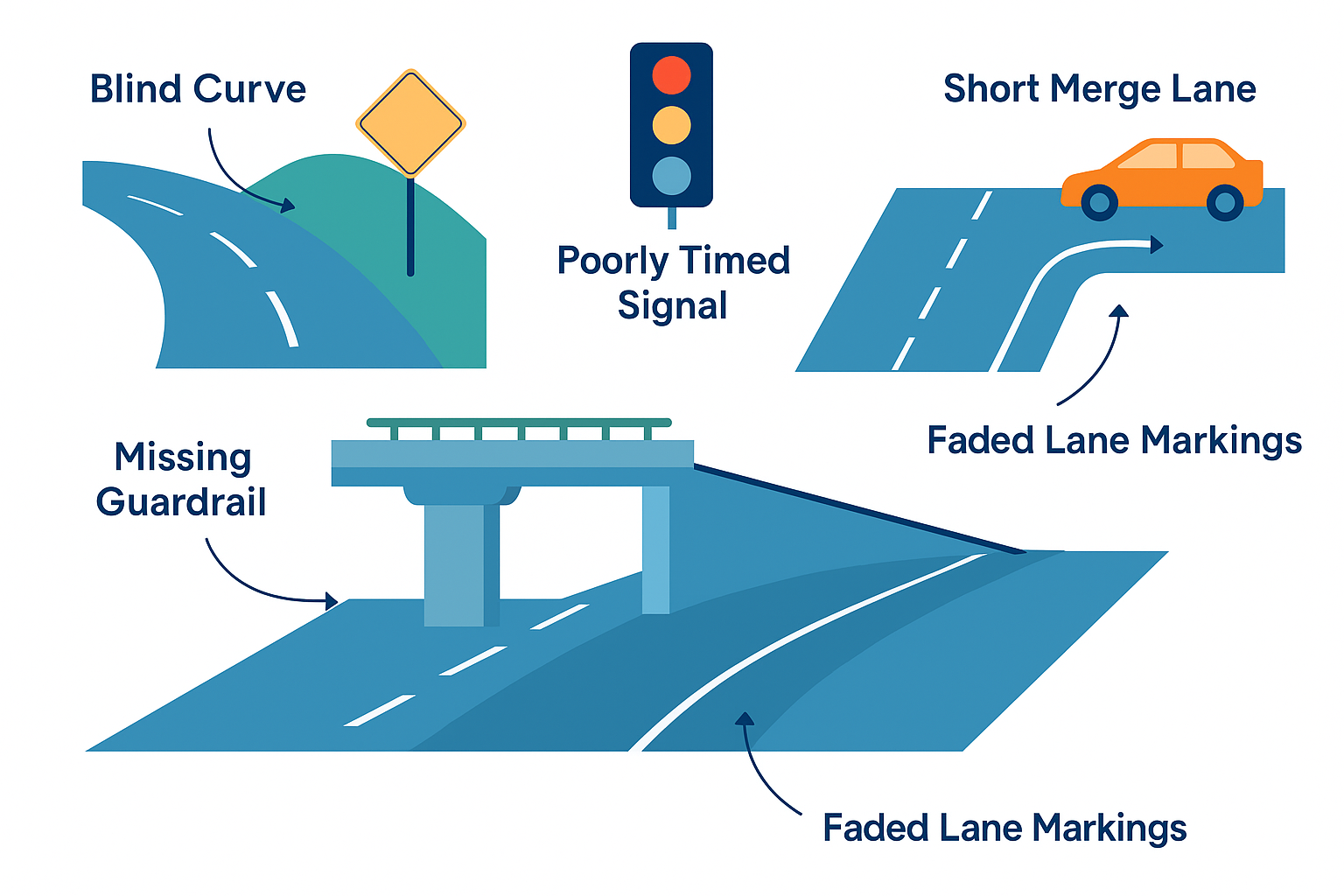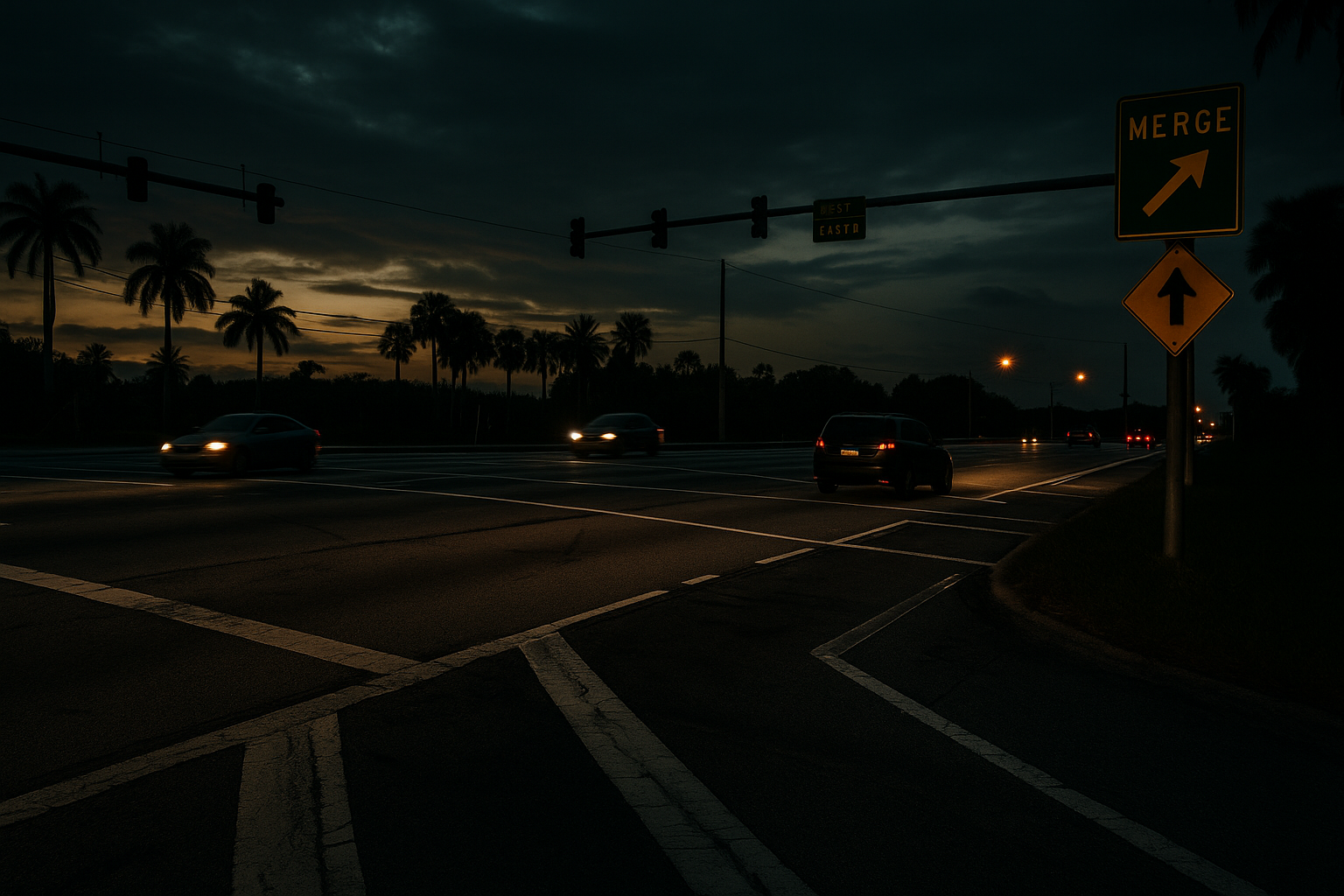Florida drivers face a sobering reality: our state is home to six of the ten most dangerous highways in America. While many accidents result from driver error, a significant number of crashes occur due to something drivers have no control over: dangerous road design. When poorly designed intersections, inadequate signage, or hazardous highway configurations contribute to your accident, understanding dangerous road design liability in Florida can help victims seek the compensation they deserve.
At Silver Injury Law, we’ve spent over 30 years helping South Florida accident victims navigate complex liability cases, including those involving government entities responsible for road safety. Not every crash is simply a “driver error” situation. Sometimes the road itself is to blame.
What Is Dangerous Road Design?
Dangerous road design refers to inherent flaws in how roads, intersections, and highways are planned and constructed. Unlike temporary maintenance issues such as potholes or debris, design defects are permanent features that create ongoing hazards for drivers exercising reasonable care.
Common examples of dangerous road design include:
- Blind curves or sharp turns without adequate warning signage
- Inadequate sight distances at intersections
- Missing or poorly positioned guardrails on elevated roadways
- Insufficient merging lanes that force dangerous highway entries
- Shoulder drop-offs that trap vehicles attempting to avoid obstacles
- Traffic signals with insufficient yellow light timing
- Crosswalks placed in high-speed areas without proper traffic control
Dangerous vs. Defective: Understanding the Legal Difference
The legal distinction between “dangerous design” and “defective maintenance” significantly impacts your case. Dangerous design involves permanent, built-in hazards that should have been addressed during the planning phase. Defective maintenance refers to deteriorated conditions like worn lane markings, broken traffic lights, or unrepaired potholes. Both can lead to liability claims, but they follow different legal pathways and involve different responsible parties.
Florida’s Unique Road Liability Laws
Florida’s legal landscape for road design liability cases involves several complex layers that accident victims must navigate carefully.
Florida’s No-Fault Insurance System Impact:
Florida operates under a no-fault insurance system, meaning your Personal Injury Protection (PIP) coverage initially handles medical expenses and lost wages regardless of who caused the accident. However, PIP coverage has strict limitations, typically $10,000 in medical benefits and $10,000 in disability benefits. When dangerous road design causes serious injuries, victims often need to pursue third-party claims to recover full compensation for their losses.
To file a lawsuit against another party (including government entities), you must meet Florida’s “permanent injury threshold.” This requires demonstrating that your injuries resulted in permanent scarring, permanent loss of bodily function, or other lasting impairments.
The Florida Tort Claims Act:
When pursuing claims against government entities for dangerous road design, the Florida Tort Claims Act governs your case with special requirements that don’t apply to typical personal injury lawsuits. Most importantly, you have only three years from the accident date to file your lawsuit (one year less than the standard four-year statute of limitations for personal injury cases). Additionally, you must provide formal notice to the government entity, and damage awards may be subject to statutory caps.
Who Can Be Held Liable for Dangerous Road Design?
Determining liability in dangerous road design cases requires careful investigation to identify all potentially responsible parties.
Government Entities:
The Florida Department of Transportation (FDOT) bears responsibility for state highways, interstates, and major arterial roads throughout our region. For local roads, liability often falls on county governments. Palm Beach County and Broward County maintain thousands of miles of roadways serving communities like Boca Raton, Wellington, Delray Beach, and Pompano Beach. Individual municipalities also hold responsibility for roads within their city limits.
Private Contractors:
Government agencies frequently hire private engineering firms to design roads and construction companies to build them. When dangerous design elements result from contractor negligence, these private entities can be held liable alongside (or instead of) government agencies. This is particularly relevant for recently constructed or renovated roadways where design flaws become apparent after completion.
Product Manufacturers:
Sometimes dangerous road conditions result from defective materials or equipment. Faulty guardrails, malfunctioning traffic signals, or substandard road construction materials can create liability for manufacturers under Florida’s product liability laws.
Given that Silver Injury Law serves areas with some of Florida’s most challenging roadways (including sections of I-95, State Road 7, and Glades Road), our local knowledge proves invaluable in identifying responsible parties and building strong cases.
How to Prove Dangerous Road Design Caused Your Crash
How Do You Prove Dangerous Road Design Caused an Accident?
Establishing that dangerous road design contributed to your accident requires comprehensive evidence gathering and expert analysis. Unlike typical car accident cases where fault might be obvious, road design liability demands technical proof that the roadway itself created unreasonable hazards.
Essential Evidence Collection:
Detailed scene documentation forms the foundation of your case. This includes photographs from multiple angles showing the road’s design features, sight line obstructions, signage placement, and any relevant traffic control devices. Weather and lighting conditions at the time of your accident also matter, as they can reveal how design flaws become more dangerous under certain circumstances.
Expert Technical Analysis:
Traffic engineering experts can evaluate whether the road meets accepted design standards and identify specific deficiencies that contributed to your crash. Accident reconstruction specialists analyze vehicle movements, impact patterns, and physical evidence to demonstrate how design flaws caused or worsened the collision.
Historical Data Investigation:
Public records revealing previous accidents at the same location strengthen your case by showing a pattern of dangerous conditions. Freedom of Information Act requests can uncover government communications about known road hazards, budget constraints affecting repairs, or previous complaints from other drivers.

What to Do If You Suspect Road Design Was a Factor
Taking immediate action after suspecting that dangerous road design contributed to your accident protects both your safety and your legal rights.
Document Everything Immediately:
If physically able, photograph the accident scene from multiple angles, focusing on road design features like curve radius, signage placement, lane markings, and sight obstructions. Video footage can capture the driver’s perspective approaching the hazardous area. Weather conditions, lighting, and traffic volume also provide important context.
Seek Comprehensive Medical Attention:
Even if you feel uninjured initially, obtain thorough medical evaluation. Some injuries don’t manifest symptoms immediately, and documented medical treatment establishes the extent of harm caused by the accident. This medical documentation becomes crucial evidence in your liability claim.
Should I Call a Lawyer If I Think Road Design Played a Role?
Absolutely. Road design liability cases against government entities involve complex procedural requirements and strict deadlines that don’t apply to typical accident claims. The three-year statute of limitations for government liability claims means evidence preservation and legal action must begin quickly. Additionally, government entities have sophisticated legal teams defending these cases. You need experienced representation to level the playing field.
The Challenges of Suing Government Entities
Pursuing dangerous road design claims against government entities presents unique obstacles that make experienced legal representation essential.
Florida’s Sovereign Immunity Laws:
Sovereign immunity traditionally protected government entities from most lawsuits, but Florida law creates specific exceptions for negligent road design and maintenance. However, these exceptions come with strict requirements and limitations that must be carefully followed. The government can still claim immunity if proper procedures aren’t followed or if the case doesn’t meet specific legal criteria.
Procedural and Financial Hurdles:
Government liability cases require formal notice procedures, detailed documentation, and adherence to rigid timelines. Additionally, Florida law caps damage awards against government entities in many situations, limiting the compensation available even in successful cases. The burden of proof is often higher than in typical negligence cases, requiring clear evidence that government employees acted unreasonably or failed to address known hazards.
Resource Disparities:
Government entities have significant resources to defend road design liability claims, including in-house legal teams, expert witnesses, and extensive documentation systems. They may argue that budget constraints, competing priorities, or engineering judgment justified their design decisions. Without experienced legal representation, individual accident victims face an uphill battle against well-funded government defense teams.
Real-World Examples: Florida’s Most Dangerous Roads
Understanding how dangerous road design contributes to accidents becomes clearer when examining specific Florida roadways where design flaws have led to numerous crashes.
US Route 1: America’s Most Dangerous Road
Running 545 miles from Key West to the Georgia border, US Route 1 passes directly through Silver Injury Law’s service area, including sections in Palm Beach and Broward Counties. This roadway’s combination of heavy traffic, frequent intersections, and mixed-use development creates numerous hazardous conditions. Design issues include inadequate turning lanes, insufficient sight distances, and intersections that handle far more traffic than originally planned.
Interstate 4: Deadliest Per Mile
While I-4 primarily affects Central Florida, its design problems illustrate common issues found throughout the state. Complex interchanges, insufficient merge distances, and heavy truck traffic create conditions where even careful drivers face significant risks.
State Road 7 (US 441): Local Danger Zone
This major north-south arterial through Palm Beach County exemplifies how dangerous road design affects Silver Injury Law’s clients daily. Frequent intersections, inconsistent lane configurations, and mixing of high-speed traffic with local access create ongoing hazards for residents traveling between Boca Raton, Delray Beach, and surrounding communities.
Hypothetical Case Scenarios:
Consider a driver approaching an intersection on Glades Road where inadequate signal timing doesn’t provide sufficient yellow light duration for the posted speed limit. A rear-end collision occurs when the lead driver stops abruptly for a yellow light, but the following driver, traveling at the legal speed limit, cannot stop safely due to the signal timing design flaw.
Another common scenario involves highway on-ramps with insufficient acceleration lanes. When drivers cannot safely merge due to inadequate merge distance, multi-vehicle crashes often result from the design deficiency rather than driver error.
How Silver Injury Law Can Help with Road Design Cases
Silver Injury Law brings over three decades of experience to dangerous road design liability cases, having served South Florida communities since 1993. Our deep understanding of local roadway systems in Palm Beach County, Broward County, and surrounding areas gives us unique insight into recurring design problems and the government entities responsible for addressing them.
Comprehensive Case Investigation:
Our team conducts thorough investigations including expert witness retention, government records acquisition through Freedom of Information Act requests, and technical analysis of road design standards. We work with traffic engineering experts who can identify specific design deficiencies and establish how these flaws contributed to your accident.
We understand the procedural requirements for government liability claims and ensure all notice deadlines and filing requirements are met precisely. Our experience with Florida’s Tort Claims Act helps avoid procedural pitfalls that could derail your case.
No Upfront Costs:
We handle all road design liability cases on a contingency fee basis, meaning you pay no attorney fees unless we successfully recover compensation for your injuries. This allows accident victims to pursue complex government liability claims without financial risk.
Our local knowledge of roads throughout Boca Raton, Wellington, Boynton Beach, Lake Worth, Palm Beach Gardens, Jupiter, and surrounding communities helps us quickly identify potential design issues and responsible parties.
Frequently Asked Questions
Can I sue if a construction zone caused my accident? Yes, but liability may involve the construction contractor, traffic control company, or government entity overseeing the project.
What evidence do I need for a road design lawsuit? Scene photographs, expert analysis, accident reports, medical documentation, and public records showing previous incidents or complaints.
How long does a government liability case take in Florida? These cases typically take 18-36 months due to complex investigation requirements and government legal procedures.
Conclusion
When dangerous road design contributes to your accident, determining liability requires understanding Florida’s complex legal framework and acting quickly to preserve your rights. The three-year statute of limitations for government entity claims, combined with strict procedural requirements, makes immediate legal consultation crucial.
Road design liability cases demand extensive technical knowledge, government law expertise, and significant resources to investigate and prove. The government entities and contractors responsible for Florida’s roadways have sophisticated legal teams defending these claims. You need equally experienced representation on your side.
If you’ve been injured in an accident where road design may have played a role, don’t let procedural deadlines or complex legal requirements prevent you from seeking the compensation you deserve. Contact us today for a free consultation. We serve clients throughout South Florida, including Boca Raton, Wellington, Delray Beach, Pompano Beach, and surrounding Palm Beach and Broward County communities.




